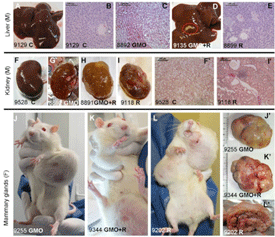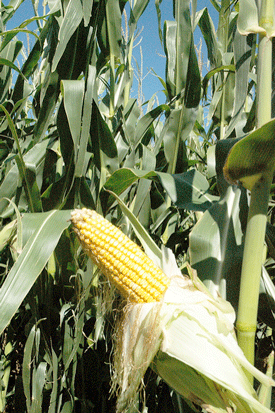New Study Links Genetically Modified Corn to Cancer
Air Date: Week of September 28, 2012

Roughly 80% of the corn grown in the US is genetically modified. (Photo: Victor Bayon)
Scientists from France recently published a study that shows massive tumors and early deaths for rats that ate genetically modified Roundup Ready corn. Living on Earth’s Bobby Bascomb tells host Steve Curwood that the controversial research questions the safety of nearly three quarters of the corn grown in the US.
Transcript
CURWOOD: A new study from France is casting doubt on the safety of a large portion of the commodity food crops we eat here in the United States. European researchers looked at the health effects of feeding Monsanto’s Roundup Ready corn to laboratory rats and their results were startling.

Seralini’s paper includes these photos of tumors found in rats that ate genetically modified corn and Rounup. (Seralini et al)
Living On Earth’s Bobby Bascomb has been investigating the study. She joins me now. Hi there, Bobby.
BASCOMB: Hi Steve.
CURWOOD: So, Bobby, what exactly was this study looking at?
BASCOMB: Well, roughly 80% of the corn that we grow here in the United States is genetically modified and nearly three quarters of it is Roundup Ready. That means it’s genetically altered to tolerate the Monsanto herbicide Roundup. So, that chemical tolerance is built right into the DNA of the corn. The research out of France was looking at the long-term health of rats fed a steady diet of Roundup Ready corn.
CURWOOD: So, what exactly did they do? What was their methodology?
BASCOMB: They had 200 rats that they split into four groups and followed for two years. One group was fed the genetically modified Roundup Ready corn that had been sprayed with Roundup. A second group was fed the GM corn not sprayed, a third group ate no GM corn but they drank water that had traces of Roundup in it at levels considered safe by the government, and a fourth group was a control – they ate no Roundup corn or water.
CURWOOD: And I understand that they found some pretty significant results.
BASCOMB: They did. Here's the lead author of this study, Gilles-Eric Seralini:
SERALINI: So we have seen after four months that the tumors began and then after one year there was high increasing of the number of tumors, up to almost every rat having two or three tumors for the female rats for the lowest doses of Roundup.
BASCOMB: So Seralini says the rats that ate the genetically modified corn, whether or not it was spiked with Roundup, or drank the Roundup-laced water, got tumors earlier than rats in the control group. They also died much earlier: 50% of male rats died early, compared to 30% not fed the Roundup corn. And 70% of females died early compared to just 20% for the rats not fed the Roundup corn.
CURWOOD: Wow, those are some pretty remarkable statistics. What did these rats die
from?
BASCOMB: Well, they had cancer, pituitary and kidney disease and tumors. The female rats especially had more large mammary tumors — those are breast cancers. And they found the male rats had four times more tumors than the control rats and developed them a year and a half earlier.
CURWOOD: Now Bobby, Roundup Ready corn has been on the market since the mid ‘90s and it's approved by the FDA. The studies before this have found it to be safe. So, how is this research coming up with such radically different results?

(Photo: Kay Ledbetter)
BASCOMB: Well, Steve, there's two things. First, the four months Seralini mentioned earlier is important. That's when they started seeing tumors. Virtually all the studies that had been done before this lasted just three months. Also, almost all the prior research was done by industry, so by Monsanto itself or researchers paid by Monsanto. Independent
scientists in the U.S. need permission from the company to get Roundup samples to work with because it’s a patented product. And Monsanto, of course, controls that very tightly.
CURWOOD: Now, what does Monsanto say about all this?
BASCOMB: Well, they declined to talk to me on tape for this story but they did issue this statement.
ANNOUNCER: “This study does not meet minimum acceptable standards for this type of scientific research, the findings are not supported by the data presented, and the conclusions are not relevant for the purpose of safety assessment."
BASCOMB: Specifically, Monsanto says the study size of 200 rats is too small. And they say that the rats used in the French study are pre-disposed to tumors and cancer. Which is absolutely true — about a quarter of the control rats that ate no Roundup corn did die early. But disease and early death in the rats that ate any amount of the genetically modified corn was two to five times higher than the control group. And these rats are exactly the same type as Monsanto uses in its own studies.
CURWOOD: Is this new research likely to change how we regulate genetically modified
foods here in the US?
BASCOMB: Well, the Food and Drug Administration says they are still reviewing the study and can’t comment. But FDA doesn’t actually require any pre-market safety
assessment of genetically modified food crops to begin with. I talked to Michael
Hansen, he’s a senior scientist at Consumers' Union. He says that genetically
engineered foods are treated like any other plant that has been bred for certain
traits.
HANSEN: Technically, they are regulated no differently than conventionally bred
plants. The FDA has actually never made a conclusion about the safety of any of
these engineered foods that are on the market.
CURWOOD: So, what’s next?
BASCOMB: Well, most scientists will tell you that we need to do more research. This study needs to be done again to see if it gets the same results. And Hansen, of Consumers' Union, says ideally with a larger number of rats, so 400 instead of the 200 used here.
HANSEN: The data are suggestive and they should require follow up with larger
sample sizes. Why can’t countries get together and do a definitive study that
everybody agrees is a proper sample size? Put up the money and see that it’s properly
done.
BASCOMB: Well, the French study cost nearly 3 million dollars so getting some international cooperation to finance further research with a larger sample size will really be key here. But considering that the vast majority of corn in our food chain is genetically modified, a few million dollars for more research looks like a bargain.
CURWOOD: Thank you, Bobby. That's Living on Earth's Bobby Bascomb.
Links
Read the Full Research Paper of the Seralini team here
Seralini's team answers questions about their GMO corn study
Living on Earth wants to hear from you!
Living on Earth
62 Calef Highway, Suite 212
Lee, NH 03861
Telephone: 617-287-4121
E-mail: comments@loe.org
Newsletter [Click here]
Donate to Living on Earth!
Living on Earth is an independent media program and relies entirely on contributions from listeners and institutions supporting public service. Please donate now to preserve an independent environmental voice.
NewsletterLiving on Earth offers a weekly delivery of the show's rundown to your mailbox. Sign up for our newsletter today!
 Sailors For The Sea: Be the change you want to sea.
Sailors For The Sea: Be the change you want to sea.
 The Grantham Foundation for the Protection of the Environment: Committed to protecting and improving the health of the global environment.
The Grantham Foundation for the Protection of the Environment: Committed to protecting and improving the health of the global environment.
 Contribute to Living on Earth and receive, as our gift to you, an archival print of one of Mark Seth Lender's extraordinary wildlife photographs. Follow the link to see Mark's current collection of photographs.
Contribute to Living on Earth and receive, as our gift to you, an archival print of one of Mark Seth Lender's extraordinary wildlife photographs. Follow the link to see Mark's current collection of photographs.
 Buy a signed copy of Mark Seth Lender's book Smeagull the Seagull & support Living on Earth
Buy a signed copy of Mark Seth Lender's book Smeagull the Seagull & support Living on Earth

